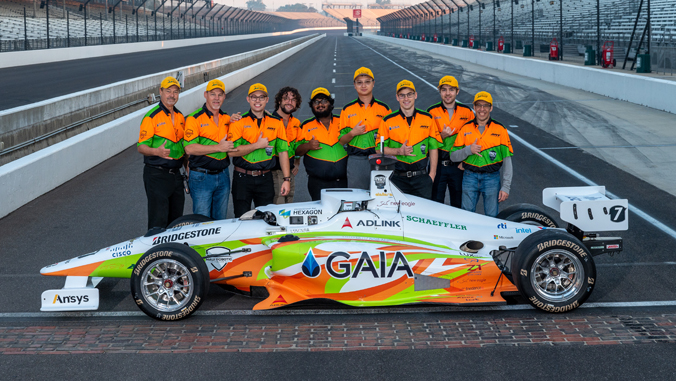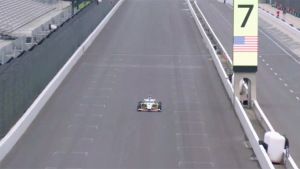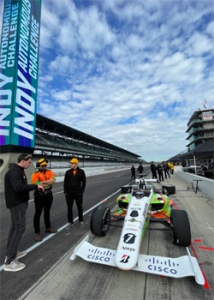
The University of Hawaiʻi made history competing in the Indy Autonomous Challenge competition—the first ever autonomous race car event. The team, UH AI Racing Tech, achieved its fastest speed ever and placed 6th in the competition.
TUM Autonomous Motorsport from Germany won the final round shootout and $1 million. Nine teams representing 21 universities in nine countries qualified for the competition on October 23 at the Indianapolis Motor Speedway, the home of the Indianapolis 500.
“On race day, we pushed our car, our code and ourselves to the limits, achieving 115 miles per hour, the fastest our car has ever gone and within 25 miles per hour of the winning speeds,” said Chris Battista, UH AI Racing Tech team member and former UH Mānoa research scientist. “It was a wild ride as we came together as a team this last week and put in the final changes and upgrades needed for the race. While we are all saddened by the car’s spinout, it was caused by hardware issues outside of our control, and we have high hopes for the next run.”
Battista added, “I’m tremendously proud of everything we’ve learned and what the team has achieved, and can’t wait to see AI Racing Tech back on the track and faster than ever, sometime in the next year.”
Generating AI to perform high speeds, tactical decisions

The Indy Autonomous Challenge is similar to other car racing competitions, minus the need for anyone behind the wheel. The driver is replaced with a variety of sensors that act as the eyes and ears of the vehicle, and a powerful computer to perform the many path planning, tactical and strategic decisions needed to provide the maximum performance from the vehicle. The system is an example of artificial intelligence, which requires engineers to create algorithms to program the car to generate human-like behaviors and interpret complex sensor data.
UH AI Racing Tech was established through a UH Maui College course in spring 2020 on autonomous vehicle technology. Gary Passon, the course’s instructor, teamed up with UH Mānoa’s College of Engineering to provide additional expertise and give students a hands-on learning experience.

UH Maui College Assistant Professors Elisabeth Dubuit and Mark Hoffman, UH Mānoa Assistant Professor Zhuoyuan Song, Battista, spring 2021 mechanical engineering alumnus Daryll Suyat, mechanical engineering junior Lillian Shibata, and partners from the private sector, as well as experts and students from the University of California, Berkeley and the University of California, San Diego, have all played a major role on the team.
The UH AI Racing Tech team is supported by several local and other industry corporations, including Maui Robotic Vehicle Association, St. Anthony School STEM program, VectorAero LLC, New Eagle LLC, ADLINK, Luxonis, PointOneNav, Emlid, RockWestComposites and others.
For more, visit the UH AI Racing Tech’s Twitter page.
This work is an example of UH Mānoa’s goals of Enhancing Student Success (PDF) and Excellence in Research: Advancing the Research and Creative Work Enterprise (PDF), two of four goals identified in the 2015–25 Strategic Plan (PDF), updated in December 2020.
—By Marc Arakaki

